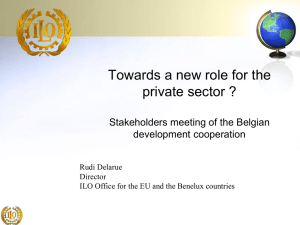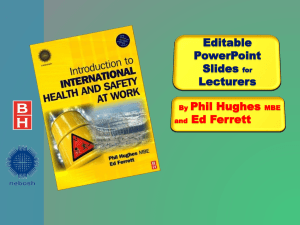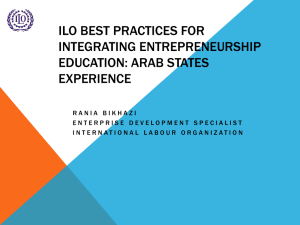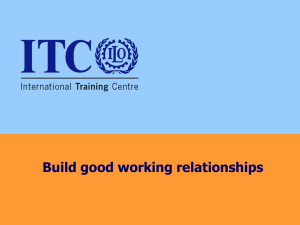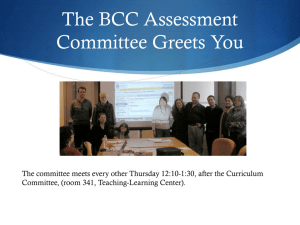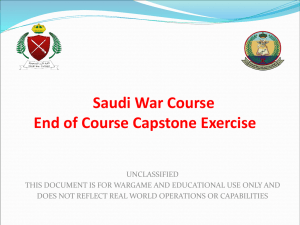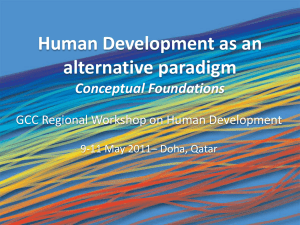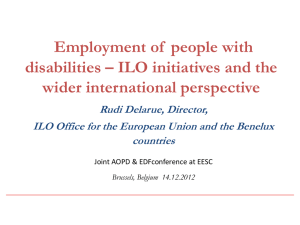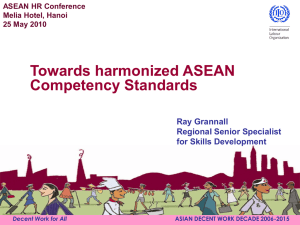The ILO and the workers of the Global Supply Chains
advertisement
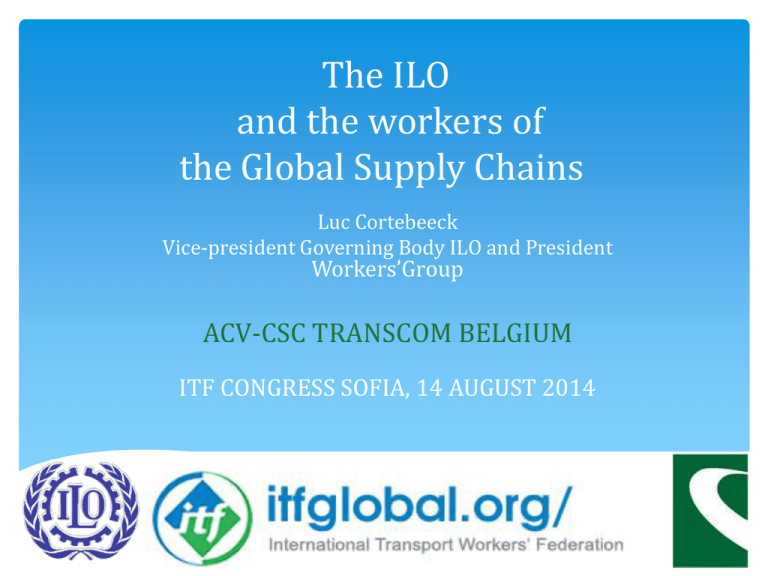
The ILO and the workers of the Global Supply Chains Luc Cortebeeck Vice-president Governing Body ILO and President Workers’Group ACV-CSC TRANSCOM BELGIUM ITF CONGRESS SOFIA, 14 AUGUST 2014 1. The ILO, what it is? 1. ILO: the INTERNATIONAL LABOUR ORGANISATION Promotes RIGHTS AT WORK; Encourages DECENT WORK, DECENT EMPLOYMENT; Enhance SOCIAL PROTECTION; Strengthen SOCIAL DIALOGUE; The only international UN-organisation supporting Workers and Workers’ rights 1. The ILO, what it is? 2. ILO: A VERY SPECIAL ORGANISATION: The only UN-organisation with three parties, deciding together: Governments; Workers; Employers ILO is a tripartite organisation; Super: the workers have a decision power at world level; But not easy: we have to decide with employers and governments 1. The ILO, what it is? 3. ILO: WHERE IT COMES FROM? 2014: Remembering the First World War; 1919: End of First World War with Treaty of Versailles: “…universal and lasting peace can be accomplished only if it is based on social justice”; ILO is founded as tripartite organisation, based in Geneva; 1946: Declaration of Philadelphia: “Work is not a commodity”. http://www.ilo.org/global/about-the-ilo/history/lang-en/index.htm 2. The ILO, how it works? 189 Conventions about Workers’ Rights have been adopted by the International Labour Conference by vote; Conventions are international treaties, if ratified, they are legally binding; If not ratified, they are a source of inspiration of the national law 202 Recommendations have been adopted (not legally binding). ILO/OIT Conseil d’Administration Governing Body International Labour Conference Conférence Internationale du Travail ILO/OIT GENEVE / GENEVA The Workers’ Group of the ILO Groupe Travailleur OIT ILO/OIT discussion with M. Funes de Rioja (empl. pres) and Guy Ryder (DG) 2. The ILO, how it works? ILO SUPERVISORY SYSTEM Commission of experts comments every year the application of standards in every country; Every year the Tripartite Committee of Application of Standards of the International Labour Conference discusses 25 difficult cases; 3 times a year the Commission of Freedom of Association discusses cases; The Governing Body discusses the most difficult situations and complaints. 2. The ILO, how it works? GUATEMALA TRIPARTITE HIGH LEVEL MISSION Guatemala September 2013 3. The ILO: strengths and weaknesses Strengths: The only international institution with a decision power for the workers; Impossible in these times wherein the neo-liberalism prevails, to create an institution with the same rights for workers; 189 Conventions and 202 Recommendations: the only international legislation in favor of workers; objectives: decent work and social protection. The most important ‘tool’ for ITUC, ITF and other Global Unions 3. The ILO, strengths and weaknesses Weaknesses: We are not alone, we have to negotiate with employers and governments; Actual dispute about the right to strike; Dealing with national legislations, not with enterprises directly. 4. From ‘Multinational Enterprises’ to ‘Global Supply Chains’ 1960: MNE’s; 1970-1980: From production-driven commodity chains…: production of labour intensive commodities in lowwage areas. to buyer-driven chains. Production of consumer goods (for example ) driven by Fashion-brands. From regional production-sharing to global chains (enormous growth in East-Asia). Washington consensus: Reagan and Thatcher followed by IMF, trade without limitations by social or fiscal laws. 4. From ‘Multinational Enterprises’ to ‘Global Supply Chains’ 1990-2000: exponential growth of Global Supply Chains (Global Value Chains): From manufacturing to energy, food, to services (transport, call centers, accountancy, medical procedures, research and development (from world leading companies) From suppliers in ownership to service-suppliers with different degrees of (in)dependency between the companies. With or without intermediation of servicecompanies (question of social responsibility) 4. From ‘Multinational Enterprises’ to ‘Global Supply Chains’ 2008… global crisis China as ‘factory of the world’; India as ‘back-office’; Brazil: agricultural commodities; Russia: natural resources and military technology; Because of lack of demand by old industrial world these countries are turning to their domestic markets. Some suppliers are becoming the new masters (Volvo owned by Geely, Chinese supplier company) 4. From ‘Multinational Enterprises’ to ‘Global Supply Chains’ Conclusion: The economic globalisation of the 21e Century is made by the Global Supply Chains and Global Value Chains; MNE’s and GSC, GVC decide about working conditions of a mass of workers in the industrialised, the emerging and the developing economies; The governance of Global Value Chains is complex (NIKE: + 800 suppliers in 51 countries with +600000 workers, NIKE has -25000 direct employed workers); They are operating with suppliers of the formal and the informal economy; To deal with this complex problem we need to be prepared, we have to know the complexity. 5. What the ILO did already? 1. The MNE-declaration (2006): Governments: ratify and apply the standards; no limitation of workers’ rights to attract MNE’s; MNE’s: are asked to obey national laws and international standards; fundamental rights at work; consultations with government and social partners; increase employment opportunities; provide wages and working conditions as do comparable employers; respect minimum wages, high standards safety and health; freedom of association and collective bargaining. P.M. OECD Guidelines (national contact points) 5. What the ILO did already? 2. ILO engagement with private sector (March 2014) Enterprise-management and Enterprise-workers delegates contact ILO to ask for guidance. GB worked out a system, controlled by the workers’ and the employers’ group to give rapid, clear and practical responses. Accord (legally binding) on Fire and Building Safety in Bangladesh. After Rana Plaza disaster, between Brands and Global Unions in and with support ILO. 5. What the ILO did already? 3. Reinforced Convention on Forced Labour (C29)(June 2014) To eradicate human trafficking; abuses and fraudulent practices during recruitment and placement process (21 million victims: mostly migrants, informal sector, supply chains); 5. What the ILO did already? 4. Transition Informal to Formal Economy Important for the Global Supply Chains; June 2014, first discussion, 2015: ILO-Recommendation. 5. International Maritime Convention (2006) The only detailed sectorial ILO-convention. 6. Conference 2016: Global Supply Chains Discussion requested by the Workers’ Group; Very difficult with employers and some governments to put it on agenda; General discussion: outcome not sure; Workers want an instrument (convention or recommendation) but need to study the complexity of the problem; ITUC wants to prepare this with Global Unions; We have to work on both: rules for enterprises and member states. 7. CONCLUSIONS Recommendations and Conventions are instruments, tools; They have to be applied in countries and enterprises, but ILO cannot do it all; Work for ITF and national sectorial unions: To negotiate International Framework Agreements with enterprises and GSC; To negociate accords on Sectorial Level; To fight together with ITUC for minimum wages, etc. ITUC and ILO-Workers’ Group fight for justice Luc Cortebeeck Third ITUC Congress, Berlin, 19 May 2014 “I do not expect any of you to be naively optimistic. But I think we may expect from any self-respecting trade unionist that they keep believing in the capacity to turn things around in a positive way, internationally as well. Provided that we opt for the right strategy towards employers and governments, and that we are able to mobilize our own base on international issues. The ILO plays a key part in this strategy. … ITUC and ILO-Workers’ Group fight for justice I call upon each and every one of you to undertake a joint effort to tackle the ILO’s future challenges … How do we get more influence on multinationals? How do we – despite the opposition of employers and governments alike – get an instrument regarding the global supply chains? The ILO clearly remains the most efficient tool to give workers the rights, the decent work and the decent life they deserve.” Thank You
